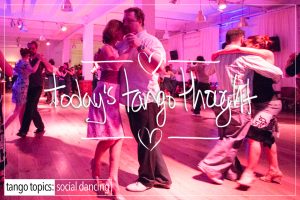First, it’s not really “Part 8” because you’re going to ask yourself, “Did I miss the other 7 topics on this stuff ?”, and the answer is a “yes” and a “no”. “Yes” because this stuff does come up a lot in these writings, and “No” because quite honestly the site hasn’t bothered to be that anal with numbering how many times this stuff is mentioned.
Secondly and to the point, the question of what to practice for most dancers is really simple. The belief is that you should practice ‘dancing’. And this is not always the case. To be fair, while Tango does require a neurological adjustment on multiple levels which can only be attained from actual dancing – this is called ‘the neurology of dancing’, this is a given. However, in order to get to that place where refinements can actually occur in one’s dance, one has to practice, one has to smooth out the rough spots of their dance. Unfortunately that almost never happens for a variety of reasons which this post is not going to cover. The point of this topic is that said ‘Practice’ is not with a partner, it is individually or solo practice. While you can do this stuff with a partner, it’s also to get in the habit of doing them by yourself, hence the ‘solo’ part. 🙂
The question of what specifically you have to practice should be obvious but isn’t. Here are some things to practice:
1.) Leg Extensions forwards & side (lead), and backwards & side (follow). Mind you this is not the weight transfers with the Extensions, just the Extensions themselves.
2.) Slow Leg Extensions on an 8 count at 20 BPM on a straight line, without crossing the line, or the natural body meridian line. This is best done with a mirror so that you can see what and how you’re doing this. Be certain not to ‘open’ or rotate your hips in doing such.
3.) Leg Extension with A Weight Transfer (slowly…very slowly…like as in 20 BPM slowly).
4.) Slow Leg Extensions with An Embrace Construct, without the Weight Transfer, while employing & reinforcing ‘good’ posture. The key component here is done slowly without compromising the embrace in any way, shape, or form. The embrace can not move in this instance, but at the same time it’s not locked in place by force, tension, or rigidity. 🙂
5.) Slow Leg Extensions, with the Embrace, and the Weight Transfer, arriving at Collection.
Sounds simple, right ? Now try doing this in socks first, and then in shoes. 🙂
What you should be doing all along in this process is videoing the entire process. Why ? You need visual feedback. But at the same time you also need to be trained what to look for and what you need to correct. Because doing this stuff by yourself without a good resource that can tell you what, where, and how to correct…then ummm…you’re pissing into the wind, sadly. 🙁
So it is for this reason that you do require some instruction as to what to correct, and how to correct for it. Mind you this website does have those resources, but this isn’t about selling that stuff to you. Today’s thought is really about giving you some thoughts about what you should be practicing. Some ideas for you to consider.
Here’s one more for when you’re at Practica: Practice your walk in the line of dance! Yes it looks a little weird, but the benefits to doing such a thing are well worth it. 1.) You work on your walk. 2.) You’re working on staying on beat. 3.) and you’re (hopefully) hitting the musical pauses. 4.) You’re working on your extensions and your weight transfers. 5.) You’re working your floorcraft.
This is about as close as you can get to dancing while still working on your own without engaging anyone else. There’s a reason you want to do such a ‘crazy’ thing, one reason only: Working with another person (ummm, what you call ‘practicing’) you are learning to compensate for them, you take on their issues, their inconsistencies, their problems, their instabilities, their embrace constraints, etc. Walking in the line of dance removes the other person’s issues from the equation so that you can focus on what you’re doing instead of their issues!











